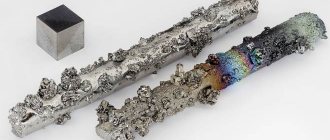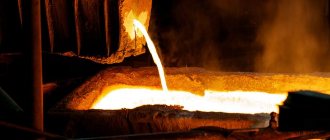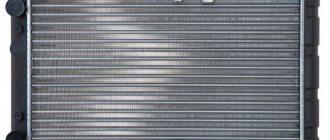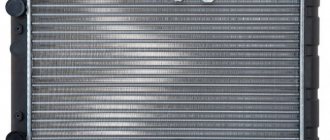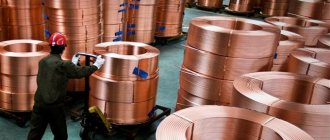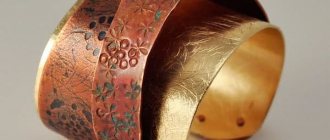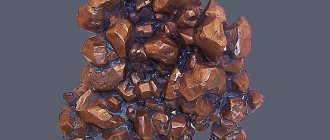Copper as an electrical conductor
Pure copper is used and used for the production of wires, cables, network conductors, and power transmission. The core of the cables is a copper core, in the production of which only very pure metal is used; any impurities reduce the effect of electrical conductivity of copper. Low resistivity allows the use of copper in electrical engineering for the manufacture of power cables and other conductors, as well as power buses carrying high currents; wires made of high-purity copper are used in the windings of electric drives and power transformers.
Copper in everyday life
Currently, when installing electrical wiring in residential premises, only wires with a copper core are allowed, which are made from high-frequency copper wire, which, in turn, is made from class A copper rod. Thus, copper wire is used in our apartments to operate all electrical appliances and lighting. The use of copper instead of aluminum in wires is due not only to the better electrical conductivity of copper, but mainly to better fire safety. Copper is less susceptible to corrosion than aluminum and reacts less with water, which allows the use of copper tubes and pipes to transfer liquids and gases in various home heating and air conditioning systems.
The use of copper in terms of thermal conductivity
The high electrical conductivity of copper is just one of the main properties that determine its widest use in everyday life and industry. The second fundamental property of copper is its extremely high thermal conductivity, which, in the presence of impurities of tin, arsenic, phosphorus, iron and other elements, drops sharply along with an increase in electrical resistance. High thermal conductivity and good heat transfer allow the use of copper in heat exchangers, heat sinks and devices where they are used - refrigerators, coolers, air conditioners. The best computer coolers use copper heatsinks to draw heat away from processors and graphics cards.
Examples of copper applications - medicine, jewelry, accessories
Currently, a wide range of studies are being carried out on the bactericidal properties of copper. It has long been believed that copper utensils help destroy pathogenic bacteria and are very hygienic. Modern scientific research suggests that the use of copper in everyday life reduces the transfer of bacteria. Thus, there are recommendations for the use of copper in hospital life and in clinics as an antiseptic. The gold products around us made of gold of different grades are the trunks of copper and gold, their proportions are called hallmarks. We see pure gold without copper, practically, only in bars that are stored in banks. Copper is one of the vital trace elements. It is involved in the process of photosynthesis and the absorption of nitrogen by plants, promotes the synthesis of sugar, proteins, starch, and vitamins. Most often, copper is added to the soil in the form of copper sulfate - copper sulfate pentahydrate. In significant quantities it is poisonous, like many other copper compounds, especially to lower organisms. In small doses, copper is absolutely necessary for all living things. Copper is also used for nickel and chromium plating of steel. You can notice that when even a drop of the silvery shiny layer is erased from shiny handles and other elements, then underneath we see not steel, but a pinkish, thin layer of copper plating. Without this layer, chrome and nickel plated parts would become shabby and ugly very quickly.
History of the discovery of copper
04/05/2010 Copper is one of the most famous and most useful metals for humanity. Although from the point of view of aesthetes, it is not included in the most famous three “noble” (gold, silver, bronze), but representatives of various professions can tell a lot of good things about this mineral: metallurgists, jewelers, physicists, chemists, pharmacists and many other specialists.
The scope of use of copper is extremely wide. Its application in various areas of heavy and light industry and individual branches of modern science is very diverse. Moreover, the number of situations where copper is irreplaceable is growing in race with technological progress, but the methods of copper mining have remained unchanged for many centuries. The possibilities of copper (and all its properties, including healing) were discovered by our ancestors back in the ancient period. Since then, almost everything in our world has changed, from people’s worldview to the socio-economic system, and copper has brought benefits to people and continues to do so.
The Latin name of this metal - Cuprum - has a very beautiful history, originating in ancient Greek mythology. According to the beliefs of the ancient Greeks, people received this metal from Aphrodite, the goddess of love and fertility. Legend has it that Aphrodite, born in the foam of coastal waves, came ashore on the island of Cyprus, which she immediately took under her protection, showing its inhabitants deposits of the metal they needed so much. Of course, there is a certain amount of truth in this beautiful legend - it was Cyprus, where one of the most famous altars of the worship of Venus was located in ancient times, since ancient times it was rich in copper deposits. So the ancient Cypriots actually got rich by mining this metal, and the name of the island gave the scientific name to this element - cuprum.
Of course, in fact, copper began to be used long before the ancient Greek civilization developed in the Aegean area. The era of the discovery and use of copper is approximately the 6th–4th millennium BC, a vast period that archaeologists and historians consider an intermediate link between the “Stone Age” and the “Bronze Age”. According to scientists' research, our distant ancestors first used copper ingots, which they mistakenly took for stones. Initially, copper nuggets were processed in the same way as simple stones - they were hit with other stones in order to change their shape and size. The copper ingots refused to split into pieces, but were perfectly deformed. This processing method, called “cold forging,” was quite energy-intensive, but very common. Unlike “hot forging,” that is, heating copper, which made the metal ductile but subsequently brittle, copper products created by cold forging withstood a lot. This also explains the advantage of copper weapons over stone ones: metal weapons could be repaired, while stone weapons could not be repaired or restored. Moreover: as soon as people found out that it was much more convenient to cut down trees with a copper tool than with a wooden one, along with copper mining there was a sharp leap in the development of the woodworking industry.
A little later, copper began to be used not only in the then weapons and agricultural industries. They began to make dishes, jewelry, and other much-needed household items from copper. An interesting fact: archaeological scientists managed to reconstruct one of the methods of making copper utensils that existed around the 5th millennium BC. In order to make a basin from a copper ingot, ancient craftsmen had to knock with a huge hammer on a copper disk placed on wooden blocks of a certain shape specially prepared for this purpose.
Excavations by historians in the territory of Anatolia (now Antalya, the Mediterranean coast of Turkey), Egypt, Iran, and Mesopotamia brought new information about both the use of copper and the methods of its processing that existed in those distant times. As it turned out, our distant ancestors had to experiment for quite a long time so that copper processed by hot forging did not lose its qualities and did not become brittle. Copper processing techniques, consisting of various combinations of casting and forging, have varied and polished over the centuries. Of course, during this period the skill of specialists increased, who began not only to make weapons, dishes and jewelry from copper, but also mastered the minting method.
It is known that copper was highly valued by the inhabitants of Ancient Egypt. After deciphering many cuneiform papyri, the method of processing copper during the reign of Ramses II became known. (1300–1200 BC) The ancient Egyptians forced air into their smelting furnaces using bellows, and extracted charcoal from acacia trees and date palms. This created the ideal temperature inside the furnaces for processing copper ingots and cleaning them from foreign impurities.
The higher the demand for copper, the more the popularity of hot forging grew. To combat the insidious fragility of copper products obtained in this way, craftsmen began to add other metals to the hot copper, forming various alloys. At some point, an accidental combination of copper and tin occurred in the smelting furnace. The resulting alloy had much more useful qualities and required completely different, less expensive processing. This substance, called “bronze,” gave impetus to the beginning of the next era, the so-called “Bronze Age,” which began around the 3rd millennium BC. During this period, bronze products partially replaced copper in certain areas of the then heavy industry, but the growth of copper mining (so necessary for the production of bronze) increased sharply.
Copper was especially popular among the ancient Greeks. For example, the inhabitants of the famous Troy, glorified in Homer’s Iliad, turned their city into the largest center for the development of metallurgy of that time, and the fortunes of both artisans and merchants grew on the noble properties of this metal.
Of course, in the era of ancient Greek civilization (and the beautiful myth of the gifts of Aphrodite), copper was used by both gunsmiths and jewelers, and doctors. Medical treatises of antiquity say a lot about the healing effects of copper products on the human body. In particular, that warriors dressed in copper armor get tired much less, and their battle wounds heal faster than those of their colleagues dressed in bronze.
Other ancient sources were devoted to the influence of copper products on various advantages of the male body. Special copper jewelry, designed specifically to strengthen the “male spirit,” was very popular among various segments of the ancient Greek population. It is known that the famous Queen Cleopatra, who was well versed in the latest medical discoveries of that time, preferred copper bracelets to any jewelry made of gold and silver, and the philosopher and playwright Aristotle, who declared the general strengthening effect of copper on the body, often fell asleep with a copper ball in his hand
The metal, which brought so much benefit to the ancient Greeks, including the inhabitants of Cyprus, who dubbed it “cuprum,” did not go unnoticed at other stages of the development of our civilization. Both in the Middle Ages and during the Renaissance, copper mining volumes grew steadily, and the best minds of those times discovered new ways of using it. The most surprising thing is that the technique of mining and processing copper later began to be used when working with other materials, in particular iron and steel. Nowadays, the demand for copper is especially high among companies specializing in the manufacture of various household and electrical appliances.
Copper in construction - down conductors, roofing
In the construction of houses, copper is invariably used as lightning rods and lightning protection. For lightning protection, a copper core 8 mm thick made of pure copper is used, that is, for this you need MM grade copper wire, since the purity of this grade of copper ensures effective current drainage. Copper sheets are also used in construction as roofing. Copper, which already has good anti-corrosion properties, thanks to the formation of a patina on the surface of sheets or strips of deoxidized copper, lasts for more than 2 centuries, during the life of at least five generations of home owners.
Copper in your home
Today, copper products are found in every home.
This material is used to create electrical wires, water and heating pipes, refrigeration equipment, air conditioners and roofing. The use of copper in both industrial production and economic activity is explained by its qualities. Products made from it are used even in extreme conditions, since copper is resistant to high and low temperatures, mechanical and chemical influences. The service life of copper products reaches 100–200 years.
Copper is ductile, durable, resistant to melting and corrosion, has high thermal conductivity and low density. Copper is safe for humans and has bactericidal properties. For this reason, it is used in water purification systems.
Applications of copper
The use of copper, as well as aluminum, which is most similar in properties to it, is well known - in the production of cable products. Copper wires and cables are characterized by low electrical resistance and special magnetic properties.
For the production of cable products, types of copper characterized by high purity are used. If even a small amount of foreign metal impurities is added to its composition, for example, only 0.02% aluminum, then the electrical conductivity of the original metal will decrease by 8–10%.
The low weight of copper and its high strength, as well as the ability to be amenable to various types of mechanical processing, are the properties that make it possible to produce pipes from it that are successfully used for transporting gas, hot and cold water, and steam.
It is no coincidence that these pipes are used as part of the engineering communications of residential and administrative buildings in most European countries. Copper, in addition to exceptionally high electrical conductivity, is distinguished by its ability to conduct heat well.
Thanks to this property, it is successfully used as part of the following systems:
- heat pipes;
- coolers used to cool elements of personal computers;
- heating and air cooling systems;
- systems that provide heat redistribution in various devices (heat exchangers).
Metal structures in which copper elements are used are distinguished not only by their low weight, but also by their exceptional decorative effect. This is precisely the reason for their active use in architecture, as well as for the creation of various interior elements.
